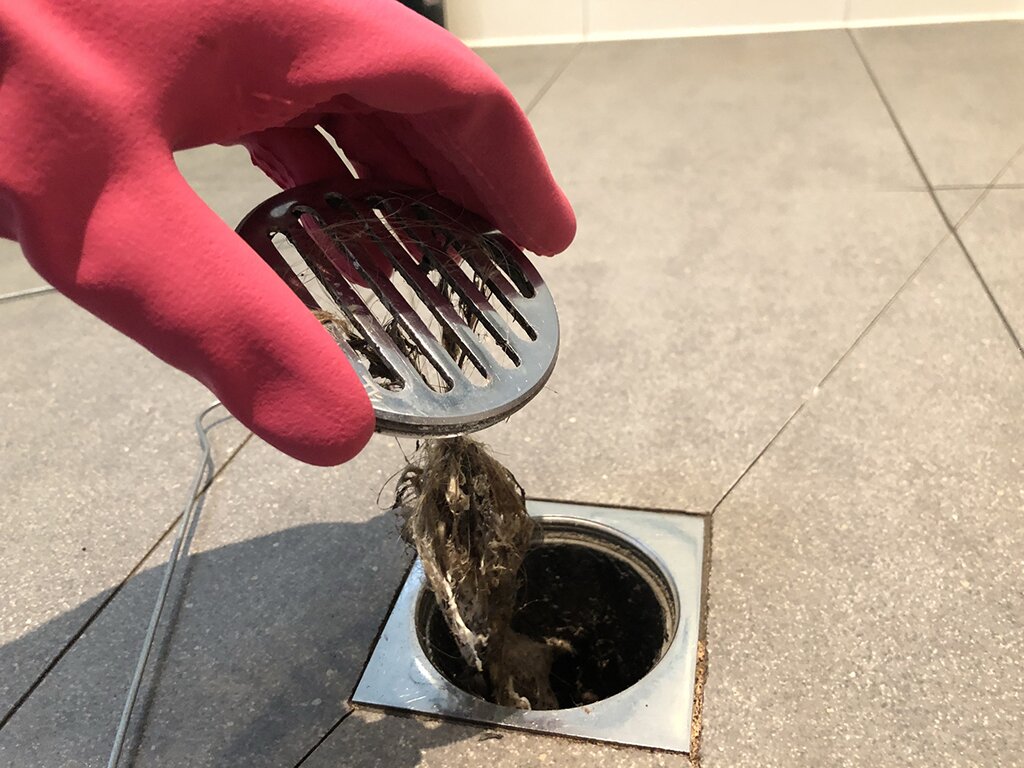If the bottom of your shower is beginning to fill up with water, you most probably have a clogged drain, and there is a very good chance that it is clogged with hair!
If you choose to open or dismantle your drain to clean it, you’ll end up with a somewhat slimy ball of hair that will be disgusting, to say the least.
Even if you regularly brush your hair before showering to avoid such buildup, nature is against you, and some will inevitably fall while showering or bathing leaving you with a drain problem sooner or later.
So, what are some other options to avoid having to open your shower drain and clean it out by hand? Does a good drain hair remover exist? Good news! There are quite a few.
The most obvious option will be to reach for a product composed of heavy-duty chemicals to dissolve your hairball, but not everyone wants to use a chemical option.
If the hair clog is really large and stubborn, a hefty dose of chemical know-how may be the only choice, however, that won’t be true in all cases.
Let’s looks at some common types of hair that clog drains and the natural remedies that can help you dissolve them with ingredients that you probably keep in your kitchen.
Types of hair that contribute to clogging
We actually tend to underestimate some types of hair when thinking about drain clogs.
1. Mustache hair. Believe it or not, mustache hair will naturally fall out during a shower and contribute to the hairball. It may not be long or thick, but it is after all hair. If you maintain a mustache, it will contribute to your clog for as long as you have it.
2. Body hair. Body hair will contribute naturally when you’re scrubbing away. Although it tends to be shorter and often thinner, it will contribute to the mass blocking your shower drain.
3. Long hair. This will not only be a problem for the ladies, but quite a few men also have thick, long manes. When taking a shower without washing your hair, a few hairs may fall off naturally. When washing your hair, you can be sure you are contributing to the clog.
Do you wash your hair every day, every other day, or twice a week? Even if you attempt to pick some of the hairs up, some of those nice soapy hairs will take up residence right in your drainpipe, adding to an obstruction.
4. Dog hair. Does Fido need a bath? A shower is very convenient when your furry four-legged friend needs to get clean. Fur! For those who have pets, fur will land just about everywhere, not only on rugs and furniture, but in sinks, tubs, and showers! If you are using your shower to give Fido a bath, count on finding his or her fur in your drain.
See also: Can a Toilet and Shower Share the Same Drain?
How can I dissolve a hair clog in my shower drain?
If the water is pooling around your feet when showering, it’s probably that you have a nice hairball in the drain or pipes. If you are looking for another option instead of purchasing a chemical product for unclogging drains, consider these tried and true “natural” methods:
1.) Vinegar and Baking Soda. This is a well-known natural cleaning combination for a number of household situations. Some will use it to remove limescale deposits, rinse washing machines or dishwashers, along with an entire list of cleaning necessities.
It’s a natural method and won’t require you to specifically go and buy a chemical product as you probably have both ingredients in your pantry.

This is a powerful duo, even for unclogging drains and dissolving hairballs. Boil a kettle full of water. Now pour the boiling water into the clogged drain and wait about a minute. During that minute combine a quarter cup of baking soda together with a cup of vinegar (white or red doesn’t matter).
Pour the mix into the drain. You may hear a reaction but that’s a good sign. Repeat this action again after about twenty minutes. After you have waited at least twenty minutes after the second treatment, turn on your shower water to evaluate improvement.
2.) Salt and Baking Soda. Another fantastic natural method is the use of salt with baking soda. Yes, baking soda is a go-to product for cleaning difficulties. Mix a half cup of salt with one cup of baking soda. This time pour this mixture into your clogged drain but let it stand overnight.
You may hear quite a bit of fizzing, but that indicates it’s at work to dissolve your unwanted wads of hair. The morning after, boil two cups of water and pour them into your drain to flush it out.
3.) Bleach. While you may think bleach is a chemical-based option, you are correct. However, most people keep a bottle of bleach on hand and bleach won’t damage your pipes. it also will dissolve the hair thanks to acidic properties.
Pour a cup of bleach into your clogged drain and wait for at least a half-hour. If there is an improvement but water is still not flowing freely, pour another cup of bleach into the drain and wait for a half-hour before running shower water to evaluate.
When considering costs, know that salt, vinegar, baking soda, and bleach cost less than a commercial drain cleaner. So, not only will you be opting for a less “industrial chemical” choice you may probably be saving some money along the way.
Whatever method you choose, make sure to wear protective gloves and a pair of protective eyeglasses or goggles.
A Last Choice Option
If none of these options works, you must have a whopper of a hairball in your drain! This leaves you with only one alternative to dissolve hair in the drain, and that is the use of chemicals. Sometimes there is no other choice available.
You can purchase a drain clog remover at hardware stores, in some supermarkets, and online. Wear PPE especially gloves and goggles and follow all of the manufacturer’s instructions on the bottle or packaging.
An added tip: unclogging your shower drain using tools
If you’re wondering how to get hair out of a drain, this method for unclogging your shower drain, unfortunately, won’t dissolve the hair, but it will unclog your drain. A hook or a snake can be inserted in the drain to pull out wads of hair successfully.
If you don’t have this tool, you can use a wire coat hanger. Anything thin and rigid with an end that is curved should pull the hairball out.
Plumbers often use a tool called a “snake” for removing hair from drains. This is inserted in the drain, once it stops at the blockage because it can’t go any further, turn the handle and it should pull up whatever is clogging your drain.
Drain clogging
While hair isn’t the culprit when it comes to clogging a drain, it certainly is among the top materials that clog a drain. Any type of oil or grease as well as soap scum will create a sticky condition that hair will cling to, compounding the problem. If the area you live in has hard water, that will contribute to the difficulty.
See also: How to Unclog a Shower head Without Vinegar?
Prevention of Drain Clogs
Here are a few suggestions for reducing the chance of drain clogs:
- Brush hair thoroughly before using the shower
- Use a sink stopper or drain protector
- Brush your pet before giving it a bath
If you are experiencing sink drain clogs, consider running the tap while shaving so the small hairs run out immediately as opposed to draining the sink all at once at the end of your shave.
Drain clogging is a problem that may at some point appear, but there’s no reason to fret about how to dissolve hair in a shower drain.
If you need an immediate solution and don’t have a drain clog remover in your cupboard, you can conveniently try one of the natural methods suggested above. Your best guarantee will be a drain protector…you may never need to unclog your drain again.

